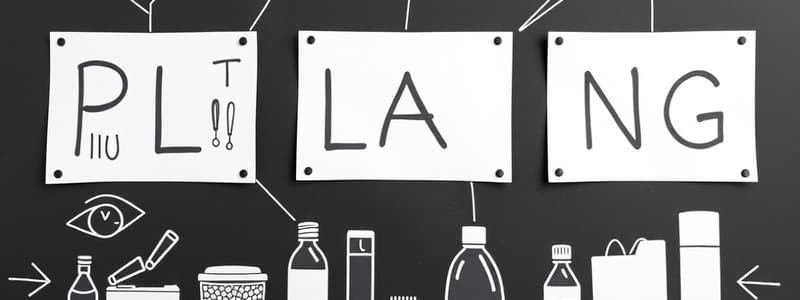Podcast
Questions and Answers
What are the elements of product planning for goods and services?
What are the elements of product planning for goods and services?
- Packaging (correct)
- Branding (correct)
- Warranty (correct)
- Product idea (correct)
What is a product?
What is a product?
Need-satisfying offering of a firm.
Goods are:
Goods are:
Seen and touched - tangible; know what you get before you get the good; typically mass produced.
Services are:
Services are:
Product assortment ____
Product assortment ____
Product line ____
Product line ____
Branding's main goal is ____
Branding's main goal is ____
What are the characteristics of a good brand name?
What are the characteristics of a good brand name?
What does the Lanham Act do?
What does the Lanham Act do?
What is a family brand?
What is a family brand?
Packaging involves ____
Packaging involves ____
What does a warranty explain?
What does a warranty explain?
What is the Magnuson-Moss Act?
What is the Magnuson-Moss Act?
What are consumer product classes?
What are consumer product classes?
What are the business product classes?
What are the business product classes?
What is the product life cycle?
What is the product life cycle?
What are the stages of the product life cycle?
What are the stages of the product life cycle?
Sales decline stage occurs when new products replace old products.
Sales decline stage occurs when new products replace old products.
What characteristics allow new ideas to move quickly through early stages of the life cycle?
What characteristics allow new ideas to move quickly through early stages of the life cycle?
How long can a product be considered a 'new product' according to the FTC?
How long can a product be considered a 'new product' according to the FTC?
What is a new product?
What is a new product?
What are the steps in the Development Process?
What are the steps in the Development Process?
Most companies experience losses during the market introduction stage.
Most companies experience losses during the market introduction stage.
What factors affect product quality measurement?
What factors affect product quality measurement?
What is a brand name?
What is a brand name?
What is a service mark?
What is a service mark?
What is a trademark?
What is a trademark?
What is a manufacturer's brand?
What is a manufacturer's brand?
What is a private/dealer brand?
What is a private/dealer brand?
What is a generic brand?
What is a generic brand?
Why do we have packaging?
Why do we have packaging?
Why do we have warranties?
Why do we have warranties?
How does the product life cycle impact marketing decisions?
How does the product life cycle impact marketing decisions?
Why are new products essential?
Why are new products essential?
What is the developmental process?
What is the developmental process?
What does TQM stand for?
What does TQM stand for?
What is ROI throughout the developmental process?
What is ROI throughout the developmental process?
How does TQM impact product management?
How does TQM impact product management?
What is the impact of place?
What is the impact of place?
What is a distribution channel?
What is a distribution channel?
What are the different types of distribution channels?
What are the different types of distribution channels?
What are the advantages and disadvantages of direct vs. indirect distribution?
What are the advantages and disadvantages of direct vs. indirect distribution?
Why use intermediaries?
Why use intermediaries?
What services provided by intermediaries are related to discrepancies?
What services provided by intermediaries are related to discrepancies?
What is channel conflict?
What is channel conflict?
What is the advantage of having a channel captain?
What is the advantage of having a channel captain?
What is integration and why is it important?
What is integration and why is it important?
What does the 80-20 rule imply?
What does the 80-20 rule imply?
What is intensive distribution?
What is intensive distribution?
What is selective distribution?
What is selective distribution?
What is exclusive distribution?
What is exclusive distribution?
What are global/international options based on cost, control, and risk?
What are global/international options based on cost, control, and risk?
What is discrepancy of quantity?
What is discrepancy of quantity?
What is discrepancy of assortment?
What is discrepancy of assortment?
What stage of the product life cycle involves informational promotion but low awareness?
What stage of the product life cycle involves informational promotion but low awareness?
What is the primary purpose of branding?
What is the primary purpose of branding?
How should managers assess products through the eyes of the consumer?
How should managers assess products through the eyes of the consumer?
Characteristics of a good brand name include being trendy and fashionable.
Characteristics of a good brand name include being trendy and fashionable.
Flashcards are hidden until you start studying
Study Notes
Product Planning Elements
- Includes product idea, branding, packaging, warranty, and classification of products.
Definition of Product
- A product is a need-satisfying offering from a firm.
Characteristics of Goods
- Tangible items that can be seen and touched; consumers generally know what to expect; typically mass-produced.
Characteristics of Services
- Intangible offerings experienced during use; cannot be owned and vary in quality; produced in the presence of the customer.
Product Assortment
- Refers to the collection of product lines and individual products offered by a firm.
Product Line
- A group of closely-related individual products.
Branding Goals
- The main goal of branding is to identify a product clearly in the market.
Good Brand Name Characteristics
- Should be short, simple, recognizable, easy to pronounce, suggestive of benefits, adaptable to packaging, and legally available.
Lanham Act
- Protects various types of marks and outlines methods for protection without enforcing mandatory registration.
Family Brand Definition
- Utilizes the same brand name across several related products, helping to unify brand identity.
Packaging Objectives
- Focuses on promoting, protecting, and enhancing the product.
Warranty Definition
- Clearly outlines the promises made by the seller regarding the product.
Magnuson-Moss Act
- Requires producers to have a clearly written warranty if they choose to offer one.
Consumer Product Classes
- Categories include convenience products, shopping products, specialty products, and unsought products.
Business Product Classes
- Categories include installations, accessory equipment, raw materials, component parts, MRO supplies, and professional services.
Product Life Cycle Stages
- Comprises market introduction, market growth, market maturity, and sales decline.
Market Introduction Characteristics
- Features low sales, negative profits, and minimal competition.
Market Growth Characteristics
- Profits peak, sales increase rapidly, and competitors enter the market due to opportunities.
Market Maturity Characteristics
- Sales peak, competition intensifies, and overall profitability declines due to rising costs.
Sales Decline Characteristics
- Sales and profits decrease as new products replace outdated ones, leading to intensified price competition.
New Product Characteristics
- Move quicker through early life cycle stages if they have comparative advantages, are easy to communicate, and align with customer values.
Definition of New Product (FTC Standard)
- A product is considered "new" for up to six months unless substantially changed.
New Product Development Process
- Consists of idea generation, screening (SWOT analysis), idea evaluation (concept testing), development, and commercialization.
Relative Quality Focus in Product Management
- Marketing managers often emphasize relative quality to differentiate their products from competitors.
Product Classification
- All goods are classified as tangible products.
Brand Recognition
- Achieved when consumers can recall and identify a brand from among other options in a store.
Green Packaging Trend
- Enhances products while promoting sustainability through recyclable or reduced materials.
Service Guarantees
- Offered instead of warranties for non-tangible services, providing assurance to customers.
Business Product Definition
- Products intended for use in the production of other goods.
Staple Product Definition
- Regularly used, frequently purchased items that require little thought.
Competitive Pricing Impact
- More crucial for homogeneous shopping products compared to specialty items.
Supplies Definition
- Expense items that do not become part of a final product.
Market Introduction Stage Losses
- Companies typically face losses during this initial stage of the product life cycle.
Market Maturity Promotions
- Characterized by rising promotion costs and price-cutting strategies from competitors.
Challenges in Mature Markets
- New entrants face competition from established firms with shrinking profit margins.
Consumer Learning Requirement
- Continuous, dynamically continuous, and discontinuous innovations vary in how much new behavior consumers must learn.
Definition of Planned Obsolescence
- Strategy that anticipates releasing new versions to replace older product lines regularly.
Concept Testing
- Involves consumer feedback to evaluate acceptance for new products.
Successful New-Product Development Factors
- Collaboration among R&D, operations, and marketing for feasibility assessment.
Product Managers in Large Companies
- Commonly oversee diverse product lines across multiple categories.
Employee Empowerment Concept
- Allowing staff autonomy to make decisions enhances customer satisfaction.
Measuring Product Quality
- Predominantly assessed through customer satisfaction levels.
Brand Name Characteristics
- Effective names are less about trends and more about clarity and pronounceability.
Decline of Industry Profits
- Profits typically start to decline during the market growth stage of the product life cycle.
Product Assessment Approach
- Managers should prioritize total consumer satisfaction and benefits.
Discrepancy of Quantity
- Represents the difference between production quantities and consumer demand.
Discrepancy of Assortment
- Indicates the gap between the product lines producers offer and the variety consumers desire.
Channel Conflict Types
- Includes vertical conflicts among different channel levels and horizontal conflicts among firms at the same level.
Channel Captain Benefits
- Guides channel relationships and helps to minimize conflicts.
Integration Benefits
- Strives for a unified distribution strategy to streamline processes.
80-20 Rule in Marketing
- Indicates that a small percentage of customers often accounts for the majority of purchases.
Intensive Distribution Strategy
- Ensures product availability across numerous outlets, often for convenience items.
Selective Distribution Strategy
- Engages a limited number of intermediaries for special attention to products.
Exclusive Distribution Strategy
- Restricts product sales to only one intermediary in a geographic area.
Global Market Strategies
- Various options weigh cost, control, and risk differently, including exporting, licensing, management contracting, joint ventures, and direct investment.
Channel Discrepancies in Supply
- Refers to the differences in quantity and assortment to address consumer needs effectively.
Studying That Suits You
Use AI to generate personalized quizzes and flashcards to suit your learning preferences.




